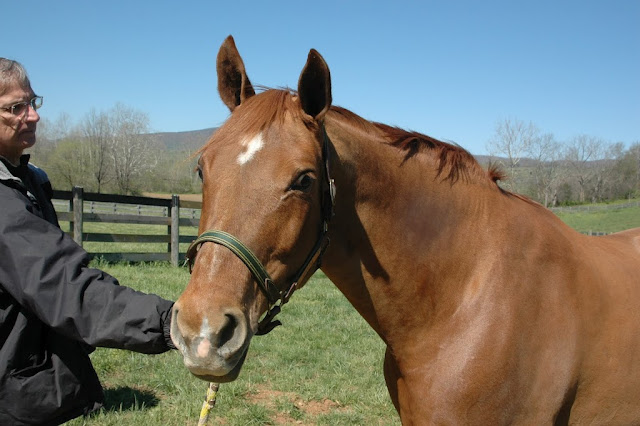Do you know what a warmblood is? Maybe you do or may you don't but I am going to give you a primer on my favorite type of horse.
Let's start by saying that there are many different types of warmbloods and you've probably heard of some of them - Dutch Warmbloods, Hanoverians, Selle Francais, Holsteiner, just to mention a few. Sega (below) is a registered Hanoverian. She was bred in the US. Her sire (her father) was a Hanoverian and her mother (dam) was a Dutch Warmblood. Each "society" has its own rules about registering a horse but the Hanoverian rules state that because her sire was a Hanoverian (and her dam has acceptable blood lines) she is registered as a Hanoverian. The Hanoverian breed originated in Germany.
April (below) is Sega's baby. April's mother and father are registered Hanoverians so it was pretty simple for her.
Many use the term warmblood loosely today but the reality is the warmblood originated in Europe several hundred years ago and were bred to be cavalry horses. They have grown in popularity in the US as they tend to be quieter than the hot-blooded thoroughbred. The only "hot-blooded" horses by the way are the TB and the Arabian. And you don't get a warmblood by crossing a hot-blooded animal with a cold-blooded animal (like a draft horse).
The warmbloods started out in Europe and were refined over a period of time to suit the tastes of the rich. The breeds were named after the regions where they were developed (Holstein, Westphalen, Oldenburg, etc) or country of origin such as Danish or Dutch. The goal was to create a horse for a type of given performance so it was to be a symbol of the owner's wealth, power or prestige. (Equine.com photo below is a Danish horse).
Over a period of time the various breeds were refined and as many areas became linked through marriages and wars, the blood among the breeds was improved. Thoroughbreds and Arabs were used to improve the breeds. In 1912, equestrian events were added to the Olympics and cavalry officers rode the horses. The Germans excelled in show jumping and the Swedish were best in dressage. After the War, horses were no longer needed for cavalry so the horses were bred to be less heavy and became more of a sport animal than a working one, working towards what we have today.
The Trakehner was one exception as these horses had always been bred to be mounts for military officers. The horses were elegant and beautiful and they had to look the part in both the battlefield and on parade. These horses tended to be higher strung and maybe harder to ride. Only Arabian and Thoroughbred blood was accepted into the studbook and this remains in effect today. (Trakehners-International photo)
Today you can't really look at a warmblood and know what breed it is and chances are it is a combination of many breeds. Today many of the European registries have parallel registries in the U.S. But registration in the US registry does not mean that a horse will be admitted in the European studbook. They are totally separate. In fact, many people still travel and buy their horses in Europe and ship them to the US as they think the breeding in Europe is far better and more advanced. And I tend to agree although we are making progress in the US.
The American Warmblood Registry was established years ago by a German woman, Sonja Lowenfish. And most breeds now have an American Registry such as the American Hanoverian Society. Both my Hanoverian mares were registered with the American Hanoverian Society. Some warmbloods have brands while others do not. Neither of my mares are branded. It can get very complicated. You can have your horse "approved" by the breeding society (which is helpful for breeding purposes, especially if you plan to sell). My older mare is approved but I have yet to put the younger one through the process but if I breed her I will do it. Both parents have to be approved in order to be registered. So my younger mare's babies cannot be registered until I have her approved. Horses can only be approved by one registry.
But beware! Many many people use the term "American Warmblood" very loosely so there are lots of people out there calling their horses American Warmbloods when in fact it is a very long stretch to say the least.
(German dressage.com photo)
I am not sure I have cleared the air about this but maybe you have a better understanding of what a warmblood is or isn't. Let's summarize by saying that a warmblood is a middle-weight horse type and/or breed probably originating in Europe that is characterized by an open studbook policy (except for Trakenhers) with the aim of breeding for equestrian sport. Can you pass the test?












Just seeing this post... what I like about the Warmblood registries is that they grade their horses, and then the get of those horses.
ReplyDeleteSo just because a horse is X breed, and happens to be a stallion doesn't mean it can be a registered stud with them, without some level of performance review. Meaning that the horse has to demonstrate that it has good quality gaits, trainability and ability in some [or several] types of riding [ie jumping and Dressage]
I wish more registries would adopt protocols like the ones the KWPN and others have for registering and grading the horses that they register.